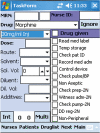Errors in the administration of intravenous medications in hospital and the role of correct procedures and nurse experience
- PMID: 21690248
- PMCID: PMC3228265
- DOI: 10.1136/bmjqs-2011-000089
Errors in the administration of intravenous medications in hospital and the role of correct procedures and nurse experience
Abstract
Background: Intravenous medication administrations have a high incidence of error but there is limited evidence of associated factors or error severity.
Objective: To measure the frequency, type and severity of intravenous administration errors in hospitals and the associations between errors, procedural failures and nurse experience.
Methods: Prospective observational study of 107 nurses preparing and administering 568 intravenous medications on six wards across two teaching hospitals. Procedural failures (eg, checking patient identification) and clinical intravenous errors (eg, wrong intravenous administration rate) were identified and categorised by severity.
Results: Of 568 intravenous administrations, 69.7% (n = 396; 95% CI 65.9 to 73.5) had at least one clinical error and 25.5% (95% CI 21.2 to 29.8) of these were serious. Four error types (wrong intravenous rate, mixture, volume, and drug incompatibility) accounted for 91.7% of errors. Wrong rate was the most frequent and accounted for 95 of 101 serious errors. Error rates and severity decreased with clinical experience. Each year of experience, up to 6 years, reduced the risk of error by 10.9% and serious error by 18.5%. Administration by bolus was associated with a 312% increased risk of error. Patient identification was only checked in 47.9% of administrations but was associated with a 56% reduction in intravenous error risk.
Conclusions: Intravenous administrations have a higher risk and severity of error than other medication administrations. A significant proportion of errors suggest skill and knowledge deficiencies, with errors and severity reducing as clinical experience increases. A proportion of errors are also associated with routine violations which are likely to be learnt workplace behaviours. Both areas suggest specific targets for intervention.
Conflict of interest statement
Figures
References
-
- National Patient Safety Agency Safety in doses: improving the use of medicine in the NHS. London: National Patient Safety Agency, 2009
-
- Phillips J, Beam S, Brinker A. Retrospective analysis of mortalities associated with medication errors. Am J Health Syst Pharm 2001;58:1835–41 - PubMed
-
- Westbrook JI, Woods A, Rob MI, et al. Association of interruptions with increased risk and severity of medication administration errors. Arch Intern Med 2010;170:683–90 - PubMed
-
- Barker KN, Flynn EA, Pepper GA, et al. Medication errors observed in 36 healthcare facilities. Arch Intern Med 2002;162:1897–903 - PubMed
-
- Colen HB, Neef C, Schuring RW. Identification and verification of critical performance dimensions: phase I of the systematic process redesign of drug distribution. Pharm World Sci 2003;25:118–25 - PubMed
Publication types
MeSH terms
LinkOut - more resources
Full Text Sources
Other Literature Sources
Medical

